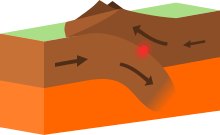This article relies largely or entirely on a single source. Relevant discussion may be found on the talk page. Please help improve this article by introducing citations to additional sources.Find sources: "List of tectonic plate interactions" – news · newspapers · books · scholar · JSTOR (January 2016)




Tectonic plate interactions are classified into three basic types:[1]
- Convergent boundaries are areas where plates move toward each other and collide. These are also known as compressional or destructive boundaries.
- Obduction zones occurs when the continental plate is pushed under the oceanic plate, but this is unusual as the relative densities of the tectonic plates favours subduction of the oceanic plate. This causes the oceanic plate to buckle and usually results in a new mid-ocean ridge forming and turning the obduction into subduction.[citation needed]
- Orogenic belts occur where two continental plates collide and push upwards to form large mountain ranges. These are also known as collision boundaries.
- Subduction zones occur where an oceanic plate meets a continental plate and is pushed underneath it. Subduction zones are marked by oceanic trenches. The descending end of the oceanic plate melts and creates pressure in the mantle, causing volcanoes to form.
- Back-arc basins can form from extension in the overriding plate, in response to the displacement of the subducting slab at some oceanic trenches. This paradoxically results in divergence which was only incorporated in the theory of plate tectonics in 1970, but still results in net destruction when summed over major plate boundaries.[2]
- Divergent boundaries are areas where plates move away from each other, forming either mid-ocean ridges or rift valleys. These are also known as constructive boundaries.
- Transform boundaries occur when two plates grind past each other with only limited convergent or divergent activity.
